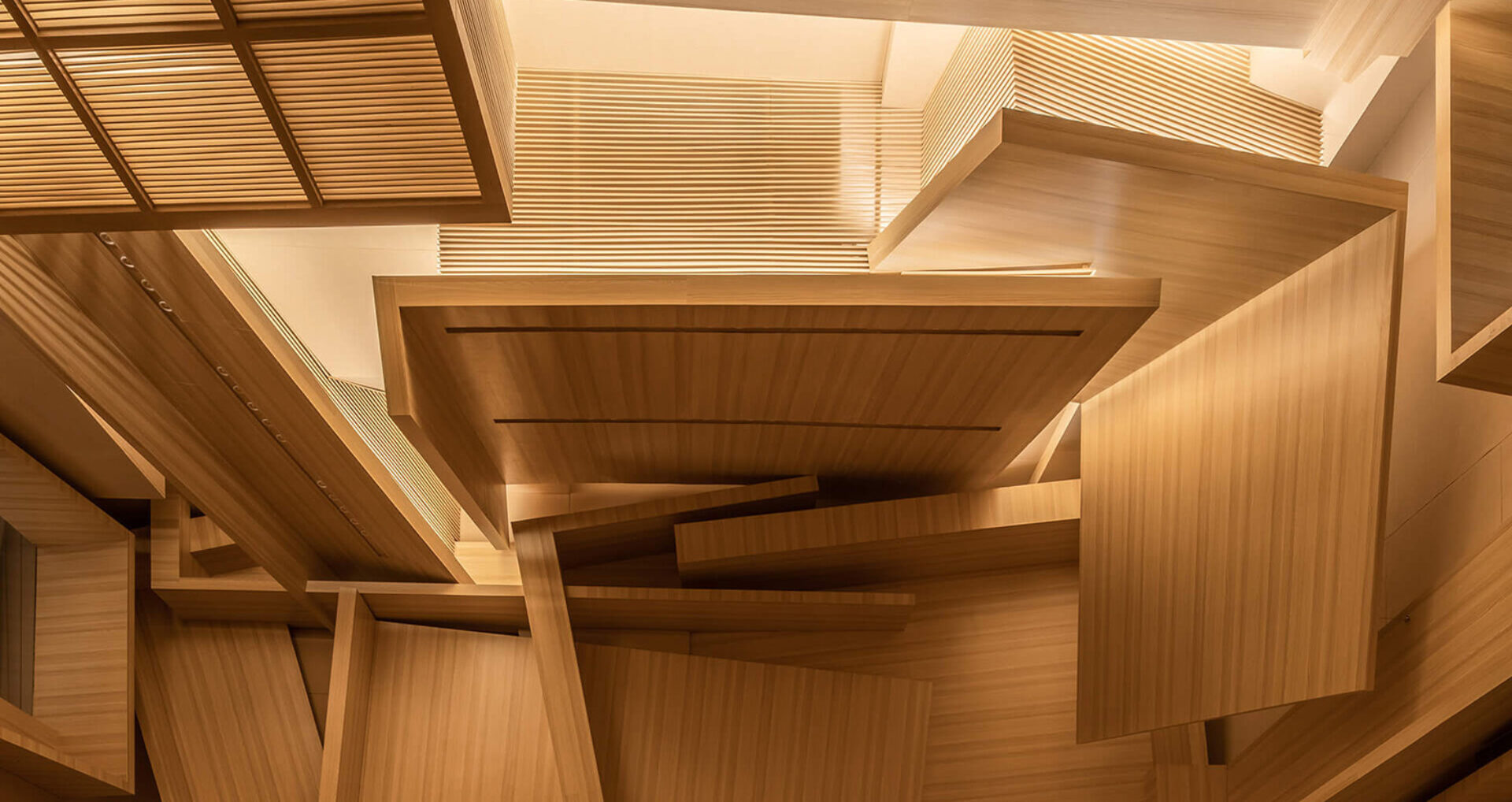(Above, Meilan Music and Small Symphony Recording Studio, photo by Vincent Wu)
This month we take a look at five ways creatives have harnessed states of being as a starting point for design. From designing to represent chaos to rethinking how we memorialize our loved ones, we look at projects that reuse a changing region's waste products, using architecture tools to re-think how we bring accountability for toxic cloud structures, and an emergency shelter that uses the the causal force as a solution.
State of Chaos:
DOMANI Architectural Concepts set out to create a space reflecting two paradigms—revisioning ways to meet strict and formulaic acoustic criteria of recording studios to one that reflects the spontaneity of improvisational music. A professional mixed-use music studio, the space includes a large live recording room, and several smaller recording rooms, and production spaces retrofitted for the needs of chamber orchestras. The resulting Meilan Music and Small Symphony Recording Studio in Guangzhou, China gives the impression of a chaotic panoply of wooden panels while meeting the rigorous acoustical requirements of material density and thickness, sound insulation, moisture and static resistance. The resulting award-winning environment is awash in the warm tones of the wood, providing an enriching and inspiring state of the art space for musicians.

State of Reuse:
Artist and designer Takuto Ohta’s project, Common Neglect Material (CNM) addresses a state of change in rural Japan as industry and an aging population has been the conduit for a liminal state. In southern coastal communities, a once thriving industrial fishing region has seen rapid depopulation resulting in discarded materials and empty spaces that no longer serve their initial purposes. In places where the landscape, trash, and abandoned infrastructure are left behind having lost their value and purpose, Ohta has created a new label to reflect their current state, “Common Neglect Material,” and in turn looked at the potential of these materials to create new value. Transforming fish containers into furniture both gives the material new life, and offers communities a way to hold on to their histories, and make use of what may be left behind as the region changes.


State of Life:
As we measure the impacts of human life and industrialization on our planet, students Louise Lenborg Skajem and Aura Elena Murillo Pérez have come up with a meaningful alternative to the pollution and land-use issues that traditional burials and cremation create, that fosters marine biodiversity, and has a net-negative carbon impact. Their project, Resting Reef, incorporates cremated remains and byproducts from food industry waste into 3D-printed “urns” in the form of structures that are used to create an artificial oyster reef. With each structure supporting the life of 100 oysters, over the course of three years can remove 5 million pounds of carbon dioxide from the atmosphere, offsetting the 500 pounds of carbon dioxide released during cremation. With the loss of 85% of the world’s oyster reefs over the last 100 years, individuals are empowered to leave behind a legacy that supports marine life and biodiversity for generations to come, and offers loved ones a beautiful coastal memorial at which to honor the lives of their loved ones.


State of Mystery:
London-based Forensic Architecture (FA), an interdisciplinary organization of architects, journalists, artists, engineers, filmmakers, and other professionals in an emergent field of study, investigate human rights and environmental violations through the lens of architecture and spatial dimensions. Their exhibition, "Cloud Studies," contrasts the beauty and mystery of natural phenomena to the poisonous and toxic reality of man-made clouds. By modeling the kinetic architecture of the spatial makeup of these somewhat invisible entities, FA strips away the mystery of how toxic man-made clouds affect environments and people—exposing the environmental racism of petrochemical companies, the hyper local, short lived effects of tear gas, and the global and long-lasting planet altering reality of war, chemical attacks, and fires. Through their modeling of this kinetic violence, FA shifts the role of art through expansive use of technology, science, and architecture creating complex studies and visual representations that shift viewer’s understandings that something as mysterious and as invisible as air itself can wreck violence.


State of Emergency:
Designers Henry Glogau and Samuel Barratt’s Deployable Emergency Shelter, winner of the 2022 Design Educates Award, Product Design, was designed using biomimicry and inspired by the regional ecosystem and history of Inuit structures. The shelter is lightweight, with an origami skin and lattice structure that allows for the use of snow capture as an insulator and protective layer, resulting in a 37°C difference between the interior and the outdoors. The internal layers use a mylar material, inspired by the ways that polar bear’s retain body heat to instead retain the human user’s body heat. Harnessing the power of the weather threats themselves, high winds and snow, the structure’s dynamic shape anchors to the ground during high winds, while the origami skin traps and snow, building an insulated layer.



